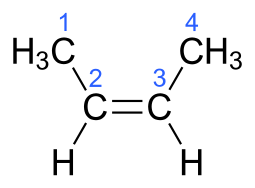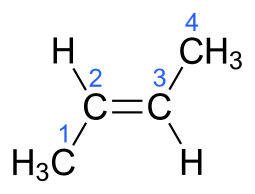Isomers have identical chemical formulae. We usually invoke isomerism with respect to organic chemistry...and we will use some simple organic compounds, #"butane"#, and #"butylene"# to illustrate our isomer. A given formula can generate several #"structural isomer"# depending on #C-C# connectivity within the molecule.
And so #C_4H_10# can generate TWO structural isomers...#"n-butane"#, #H_3stackrel(1)C-CH_2CH_2stackrel(4)CH_3#, and #"isobutane"#, #H_3stackrel(1)C-stackrel(2)CH(CH_3)stackrel(3)CH_3#...significantly, the carbon-carbon connectivity within the chain is DIFFERENT...and we can see this by the assigned numbers...
But we can go to an unsaturated formula, i.e. #C_4H_8#, we have greater opportunity for both structural and GEOMETRIC isomerism..
There are FIVE structural isomers: #(i)# #"1-butylene"#; #(ii)# #"2-butylene"#, #(iii)# #"methylpropylene"#, #H_3C-C(CH_3)=CH_2#, #(iv)# #"cyclobutane"#, and #(v)# #"methylcyclopropane"#. Have I got them all?
Now #"2-butylene"# CAN GENERATE TWO GEOMETRIC ISOMERS...which have identical #C-C# connectivity, but different geometry...
 )
)
 )
)
We note (i) that the #C-C# connectivity is THE SAME for each isomer...#C1# connects to #C2#....connects to #C4#...however, given the constraints of the olefinic bond, TWO DISTINCT GEOMETRIES can be generated...and these geometries result in different physical and chemical properties. The former has a normal boiling point of #3.7# #""^@C#, and the for the latter, we got...#0.9# #""^@C#.
The isomers will differ in reactivity in addition....
And there is a further refinement to isomerism, #"optical isomerism"#, but I am not going to open that can of worms now.
 )
)  )
) 
